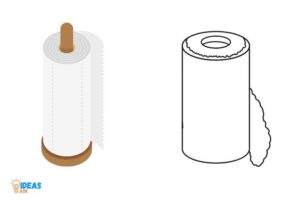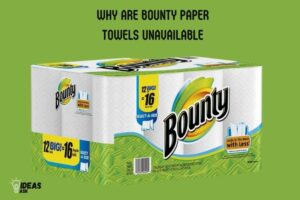Difference Between Paper Towel And Tissue Paper: A Guide!
The primary difference between paper towels and tissue paper lies in their distinct uses, manufacturing process, and absorbency level.
Paper towels are designed for cleaning purposes and are heavier, stronger, and more absorbent, while tissue paper is lighter, softer, and typically used for personal hygiene or gift wrapping.
Paper towels are usually two-ply and made from strong, thick paper fibers to enhance their absorbency, making them ideal for cleaning spills or drying hands.
On the other hand, tissue paper is made from lighter, more delicate paper materials, making it soft and gentle for use on the skin. Tissue paper is commonly used for facial tissues, bathroom tissues, or gift wrapping.
Key Takeaway
7 Aspects: Difference Between Paper Towel And Tissue Paper
| Aspect | Paper Towel | Tissue Paper |
|---|---|---|
| Material | Usually made from virgin paper pulp | Often made from recycled paper pulp |
| Strength | Stronger, designed to absorb liquids | Softer, designed for delicate use |
| Texture | Coarser texture for better absorption | Smoother and thinner for comfort |
| Usage | Cleaning surfaces, drying hands, soaking up spills | Wiping face, blowing nose, wrapping gifts |
| Price | Generally more expensive due to production cost | Usually cheaper due to lighter weight and thinness |
| Environmental Impact | High, as it uses more resources in production | Lower, often made from recycled materials |
| Durability | Durable, can withstand scrubbing and wiping | Not very durable, can easily tear when wet |

Differences Between Paper Towels And Tissue Paper
There are several types of paper products that provide convenience in our daily lives. Paper towels and tissue paper are two such products that are used frequently, but they have different characteristics.
Absorbency Rate
- Paper towels have a higher absorbency rate as compared to tissue papers.
- They are designed to clean up spills and messes.
- The thickness of paper towels ensures that they do not break apart even when wet.
- Tissue papers, on the other hand, have lower absorbency rate and are not effective in cleaning up spills.
Durability
- Paper towels are more durable as compared to tissue paper.
- They are designed to withstand tough cleaning tasks and can be used multiple times.
- Tissue papers are delicate and tend to tear easily, making them better suited for gentle wiping tasks.
Strength
- Paper towels are stronger than tissue papers.
- They remain intact even when wet and can be used for heavy-duty cleaning tasks.
- Tissue papers are not as strong as paper towels, and they tend to tear apart when used for tough cleaning tasks.
Softness
- Tissue papers are softer as compared to paper towels.
- They are designed to be gentle on the skin and are often used for personal hygiene purposes.
- Paper towels are rough and may not be suitable for use on sensitive skin.
Intended Usage
- Paper towels are intended for cleaning tasks and are used to clean spills, grime, and dirt.
- They are often used in kitchens and bathrooms for cleaning countertops, sinks, and toilets.
- Tissue paper is designed for personal hygiene purposes and is used for wiping the face, nose, and mouth.
- Tissue paper is also used in households for wiping down surfaces, but it is less effective in cleaning up tough messes.
Paper towels and tissue papers are both essential products that offer convenience in our daily lives. However, they have different characteristics and intended usage. It is important to choose the right product based on the task at hand to ensure effective cleaning and hygiene.
Understanding Paper Towels
Paper towels and tissue paper have been around for decades and are commonly used for various purposes. Tissue papers are soft, thin, and smooth, and they are primarily used for hygienic purposes such as wiping faces for cleaning or as a substitute for toilet paper.
Characteristics Of Paper Towel
Paper towels are absorbent, paper-based products that are used for various cleaning and drying purposes, such as cleaning up spills, wiping surfaces, and drying hands.
Some of the key characteristics of paper towels include:
- Strength: The biggest advantage of paper towels is their strength, which allows them to hold up even when wet, unlike tissue paper.
- Absorbency: Paper towels are designed to absorb moisture, and they can be used to mop up spills, wipe surfaces free of moisture, and dry dishes.
- Softness: Premium quality paper towels are soft and gentle to touch, making them ideal for wiping sensitive surfaces, such as eyeglasses or computer screens.
- Thickness: Paper towels usually have a higher thickness than tissue paper, making them more durable and long-lasting.
Manufacturing Process Of Paper Towel
The manufacturing process of paper towels is quite simple, and it involves the following steps:
- Wood pulp is mixed with water to create a pulp solution.
- The pulp solution is then passed through a series of rollers, which squeeze out the excess moisture and flatten it into thin sheets.
- These sheets are then pressed and dried to remove any excess moisture.
- The dried sheets are crimped, embossed, or stamped to create design patterns, increase absorbency, and improve softness.
- The finished product is then cut into individual rolls or sheets for packaging.
Types Of Paper Towels Available In The Market
There are various types of paper towels available in the market, each with its unique features and benefits.
Some of the most common types of paper towels include:
- Standard paper towels: These are the most commonly used paper towels and are designed for general purposes, such as cleaning up spills, wiping surfaces, and drying hands.
- Multi-fold paper towels: These paper towels are designed to be used in public restrooms and are usually found in dispenser boxes.
- Roll paper towels: These are larger rolls of paper towels that are ideal for households and businesses that require more extensive cleaning and drying of surfaces.
- Disposable paper towels: These are single-use paper towels that are convenient for cleaning and maintain good hygiene in public spaces.
Benefits Of Using Paper Towels
Paper towels offer several advantages over other cleaning and drying products.
Some of the benefits of using paper towels include:
- Hygiene: Paper towels are disposable; therefore, they reduce the risk of spreading harmful bacteria and viruses from one surface to another.
- Convenience: With paper towels, there is no need to launder or wash dirty towels and cloths. Paper towels can simply be thrown away after use.
- Versatility: Paper towels have multiple uses, making them an excellent all-purpose cleaning and drying product. They can be used to clean surfaces, mop up spills and dry dishes.
- Environmental friendliness: Some manufacturers produce eco-friendly paper towels made from recycled paper, which can be more sustainable and reduce waste.
With these characteristics, types, and benefits of paper towels in mind, you can make the best choice for your cleaning needs.
Understanding Tissue Paper
Are you someone who confuses tissue paper with paper towels or vice versa? Despite having some similarities, there are significant differences between the two that are essential to understand.
Characteristics Of Tissue Paper
Tissue paper is a thin, lightweight, and soft paper-based product used primarily for personal hygiene purposes like wiping your face or blowing your nose.
Below are some key characteristics of tissue paper:
- Made from high-quality paper pulp
- Available in different colors, sizes, and plies
- Highly absorbent and gentle on the skin
- Biodegradable and eco-friendly
- Cost-effective and widely used across the globe
Manufacturing Process Of Tissue Paper
The manufacturing process of tissue paper surpasses conventional paper production methods. The process involves cutting and grinding the wood chips and leaves to form a pulp.
The pulp is then bleached and refined before being rolled and converted into tissue paper using the yankee dryer machine.
Types Of Tissue Paper Available In The Market
There are several types of tissue papers available in the market. A few significant types are:
- Facial tissue: Used explicitly for facial cleaning and soft on the skin.
- Toilet paper: Used for personal hygiene purposes and is biodegradable.
- Paper napkins: Used for wiping the hands and mouth during and after meals.
- Tissue towels: Used for cleaning purposes such as wiping spills or surfaces.
Benefits Of Using Tissue Paper
Tissue papers are universally used by individuals and businesses alike. Here are a few benefits of using tissue paper:
- Tissue papers are soft and gentle on the skin, making them ideal for facial use.
- They are highly absorbent, making them an excellent choice for cleaning and absorption purposes.
- Tissue papers are affordable and readily available, making them accessible for everyone.
- Tissue papers are eco-friendly and biodegradable, leading to a decrease in environmental pollution.
Understanding the differences between paper towels and tissue paper is critical to using them effectively and efficiently. With the information provided in this post, you can make an informed decision on which product to use based on your needs.
Environmental Impact
Comparison Of Environmental Impact Of Paper Towels And Tissue Paper
Both paper towels and tissue paper impact the environment, but which one is worse?
Here are some points to consider:
- Paper towels are usually made of virgin pulp, which requires cutting down trees. Tissue paper, on the other hand, is often made of recycled paper.
- Paper towels are designed for single-use, which means that they create more waste than tissue paper. Tissue paper can often be used multiple times before being discarded.
- Paper towels are often packaged in plastic wraps, which adds to the plastic waste problem. Tissue paper, however, usually comes in paper packaging, which is easier to recycle.
- Paper towels are larger and more absorbent, which often means that people use more of them than they need. On the other hand, tissue paper is smaller and easier to control, which means that people use only what they need.
Sustainable Alternatives To Paper Towels And Tissue Paper
If you’re concerned about the environmental impact of traditional paper towels and tissue paper, here are some alternatives to consider:
- Reusable cloth towels: These can be washed and used multiple times, reducing waste and saving money in the long run. They come in a variety of materials, such as cotton, microfiber, and bamboo.
- Handkerchiefs: Instead of using tissue paper, consider using handkerchiefs that can be washed and used repeatedly.
- Bidets: Bidets are becoming more popular in the united states as a way to reduce toilet paper usage. Bidets use water to clean instead of paper, reducing waste and saving money.
Advantages Of Using Sustainable Alternatives
Using sustainable alternatives to paper towels and tissue paper comes with several advantages:
- Cost savings: While reusable cloth towels and bidets may have a higher upfront cost, they can save money in the long run because they can be used multiple times.
- Environmental benefits: Sustainable alternatives reduce waste and help conserve resources.
- Health benefits: Reusable cloth towels and bidets can be less abrasive on the skin than traditional paper towels and tissue paper. Handkerchiefs can also be gentler than tissue paper, reducing the risk of skin irritation.
Making small changes like switching to sustainable alternatives can have a significant impact on the environment and your wallet. Consider the options that work best for you and your lifestyle, and make a conscious effort to reduce your waste and help the planet.
Conclusion
After examining the key differences between paper towels and tissues, it’s clear that each product is unique in its own way.
While both are made of paper, they serve different purposes and have their own benefits. Tissue paper is designed for facial use, with a soft texture that is gentle on delicate skin.
On the other hand, paper towels are more durable, ideal for tough cleaning tasks like spills and stains. It’s important to note that both paper towels and tissues are eco-friendly options, as they are highly recyclable and biodegradable.
Ultimately, the decision of which product to use comes down to personal preference and the intended use.
With this knowledge, you can make informed decisions on which product is best suited for your specific needs, whether it be a tissue for a runny nose or a paper towel for a kitchen spill.






